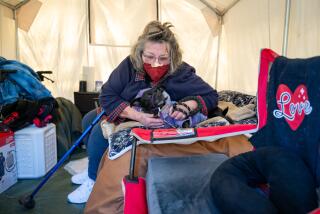Pulse of the Drum : The Hide-Covered Symbol of Indian Culture Echoes in Ears, Hearts at Ojai Powwow
- Share via
The drum plays a major role in Indian culture.
That message reverberated through the cavernous gymnasium at Matilija Junior High School last week as several hundred Indians and curious onlookers gathered for a 12-hour bash billed as the first Ojai Inter-Tribal Pow-Wow.
From the first somber, plodding beat laid down by the Silver Eagle Drum Society during the opening ceremony to the wildly frenetic rhythm of an Aztec fire dance, a percussive pulse served as the common denominator between spectators and members of the 25 tribes represented at the Saturday event.
“At some point your subconscious is going to relate to these sounds,” said Ken Little Fish, a 41-year-old Chippewa drummer from El Rio. “It’s going to awaken a primordial feeling within you. Your senses will be heightened. And that will create a bonding between us and you.”
Provides Groceries
Proceeds from the $5 admission price benefitted the Church of the Native American Food Pantry of Ventura County, a nonprofit organization that provides groceries for about 120 low-income families every month.
Church leader Cosma Childs said she founded the food pantry in her El Rio garage last year as a service for the estimated 5,000 Indians who have faded into the faceless ranks of Ventura County’s poor.
“Where are they?” she said. “We hope that things like this will bring them out.”
What the powwow did bring out was a festive crowd intent on celebrating the rich traditions of Indian culture, even if it had to be done on a gym floor bounded by six basketball hoops.
There were intertribal dances, an Indian comedian, songs to honor the dead, buckskin robes, traditional fry bread, beaded jewelry, authentic tomahawks and, always, the totemic hide-covered drum that dominated the action from the middle of the powwow.
“What is happening here is a revival,” said Mike Little Deer, a Santa Clara Pueblo Indian, who drove to the powwow from Fresno. “It shows that Indian people are human beings. They’re great. They have a life style. Even in this modern, technological world of ours, they’re still maintaining themselves.”
Antonio Romero, a Chumash Indian from the Santa Ynez Reservation, said the event was important enough to merit a holiday from his seven-day-a-week job at the reservation’s bingo hall.
“This is learning from the past,” he said. “I get to rebuild my culture and my spirit here.”
And Frances Lawrence, when asked the secret behind the deep-fried bread she was preparing, made it clear that even Indian treats have a spiritual side.
“You say a prayer before you mix it,” she said. “A prayer for the bread itself, for the good taste and for the food that’s going to go into the bellies.”
So pervasive were those warm and harmonious feelings that organizers invited non-Indians to participate.
New Age entrepreneurs were hawking their customary crystals, and white activists sat at a table eager to explain U. S. transgressions in Central America.
On the gym floor, dozens of audience members joined the traditionally dressed Indians in a circular, foot-stomping dance.
“The vibe’s up,” said Kwame Marc, a guitarist for the Los Angeles reggae band Kushite Raiders, who played several songs at the event. “The more we realize our sameness, the more we can make a harmony.”
And the harmony of the first Ojai Inter-Tribal Pow-Wow was backed all day by the rhythmic pulse of the drumbeat, a sound that Indians say is the lifeblood of their people.
Tony Moore, owner of an Indian crafts store in Ojai and a member of the Silver Eagle Drum Society, reveled in that sensation after pounding out a moving beat with six other drummers.
“That drum really brought out feelings that people didn’t even know they entertained,” he said.
“It really brought a lot of people alive.”
More to Read
Sign up for Essential California
The most important California stories and recommendations in your inbox every morning.
You may occasionally receive promotional content from the Los Angeles Times.













